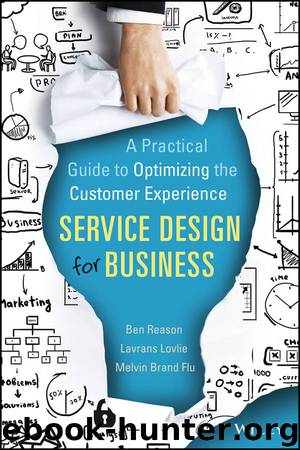Service Design for Business: A Practical Guide to Optimizing the Customer Experience by Reason Ben & Løvlie Lavrans & Brand Flu Melvin

Author:Reason, Ben & Løvlie, Lavrans & Brand Flu, Melvin [Reason, Ben]
Language: eng
Format: epub
ISBN: 9781118988947
Publisher: Wiley
Published: 2015-12-27T16:00:00+00:00
How to Develop Business Concepts
Developing new concepts starts by identifying the need for a new way of doing business. Service design can help do so in three ways. The approach offers tools to collate pain points; it also provides methods to map customer and market trends onto lifecycles—and offers approaches to look at parallel models in different sectors. Service design also helps to validate new concepts by using scenarios and storytelling.
Business concepts start with clearly defined business problems. They may be a frustration with the complexity of the business or lack of direction or a specific pain point like customer churn or low margins. Identifying and naming these pains through internal discussions, or even work sessions that bring together a range of people from across the business, help to define the problem. Collating pain points from a number of people is likely to create patterns as different people bring up similar issues. These can be synthesized into a small number of core problems to address.
More-disruptive or opportunist business concepts can be initiated in a similar way but with less pain. Views on a market or a sector can be collated from experts and experienced professionals to create a similar assessment of the opportunity space. The people who started the first low-cost airlines would have seen how there was flab in the sector, unnecessary costs, and the opportunity to do things in a more lean fashion.
Unlike customer experience challenges, business concepts are more concerned with markets and customers en masse than customer needs. Feeding market and customer trends into your sector analysis helps to see the patterns and changes in your customer base or addressable market. What are the big trends in the market? What are customers doing differently compared to what they used to do? What are the trendsetting customers doing? What are influences of government policy changes?
For example, a business-to-business service mapped the market to its lifecycle and broke down the market by size of company. They found that while the larger companies were staying loyal and using their service effectively, smaller businesses were resigning their accounts with much higher frequency. This led them to investigate new ways of doing business with smaller firms and explore new pricing models and terms of agreement that would work for this section of the market.
Understanding the actors and factors influencing customers from the outside in enables us to get a better handle on what is going on in the market. Actors are the other people or organizations that customers interact with. It could be other businesses that customers use setting a new example of how to do business or individuals in customers' lives such as family members and how those interpersonal relationships are changing. Factors are more abstract influences such as government policy, economic conditions, or changing social norms.
To ground these actors and factors, they can be related to the customer or consumer lifecycle by asking how they influence customer behavior and where in the cycle. Do they influence the size of
Download
This site does not store any files on its server. We only index and link to content provided by other sites. Please contact the content providers to delete copyright contents if any and email us, we'll remove relevant links or contents immediately.
Bad Blood by John Carreyrou(6559)
Rich Dad Poor Dad by Robert T. Kiyosaki(6414)
Principles: Life and Work by Ray Dalio(6236)
Playing to Win_ How Strategy Really Works by A.G. Lafley & Roger L. Martin(5945)
Management Strategies for the Cloud Revolution: How Cloud Computing Is Transforming Business and Why You Can't Afford to Be Left Behind by Charles Babcock(4528)
The Confidence Code by Katty Kay(4193)
Thinking in Bets by Annie Duke(4154)
American Kingpin by Nick Bilton(3762)
Delivering Happiness by Tony Hsieh(3369)
Project Animal Farm: An Accidental Journey into the Secret World of Farming and the Truth About Our Food by Sonia Faruqi(3179)
The Power of Habit by Charles Duhigg(3063)
The Tyranny of Metrics by Jerry Z. Muller(3008)
Brotopia by Emily Chang(3002)
Mastering Bitcoin: Programming the Open Blockchain by Andreas M. Antonopoulos(2986)
The Marketing Plan Handbook: Develop Big-Picture Marketing Plans for Pennies on the Dollar by Robert W. Bly(2978)
I Live in the Future & Here's How It Works by Nick Bilton(2941)
The Content Trap by Bharat Anand(2864)
Building a StoryBrand by Donald Miller(2844)
Applied Empathy by Michael Ventura(2839)
